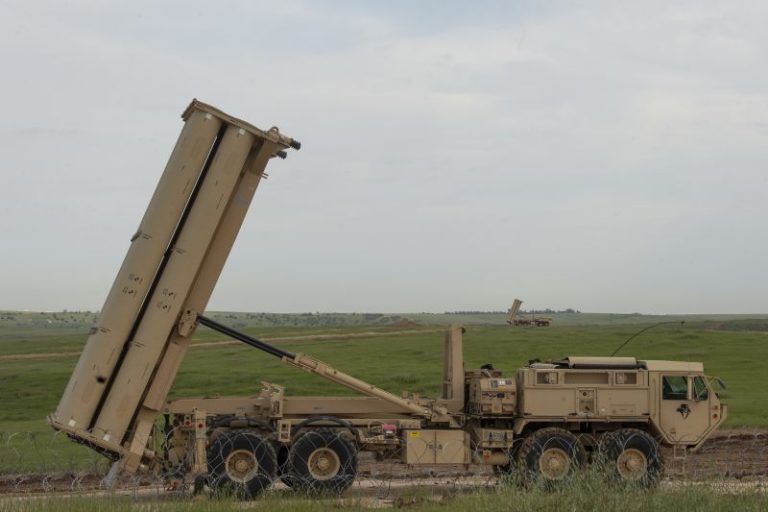The THAAD defense system is one of the US military’s most powerful anti-missile weapons, capable of intercepting ballistic missiles at ranges of 150 to 200 kilometers (93 to 124 miles) and with a near-perfect success rate in testing.
Using a combination of advanced radar systems and interceptors, THAAD, short for Terminal High-Altitude Area Defense, is the only US missile defense system that can engage and destroy short-, medium-, and intermediate-range ballistic missiles both inside or outside the atmosphere during their terminal phase of flight – or dive on their target.
THAAD interceptors are kinetic, meaning they take out incoming targets by colliding with them rather than exploding near the incoming warhead.
According to a report by the Congressional Research Service, the US military has seven THAAD batteries, each consisting of six truck-mounted launchers – with eight interceptors apiece – a powerful radar system and a fire control and communications component.
One of those prized batteries is now being dispatched to Israel to help bolster its already impressive ability to counter incoming missiles “following Iran’s unprecedented attacks against Israel on April 13 and again on October 1,” according to the Pentagon. But to do that, it needs US boots on the ground.
Through a broad command and control and battle management system, THAAD batteries can communicate with a range of US missile defenses, including Aegis systems – commonly found aboard US Navy ships – and Patriot missile defense systems that are designed to intercept shorter-range targets.
Those other missile defense systems are more numerous than THAAD, an illustration of the importance the Biden administration is placing on this deployment to Israel.
THAAD can be quickly deployed by US Air Force cargo aircraft like the C-17 and C-5, but the Pentagon did not give a timetable for when it will be active in Israel.
What makes THAAD so accurate?
What makes THAAD so accurate is the radar system that supplies its targeting information, the Army Navy/Transportable Radar Surveillance radar, or AN/TPY-2.
The radar system, which can deployed with the missile battery or already be in place on US Navy ships or at other installations, can detect missiles in two ways. In its forward-based mode it is configured to acquire and track targets at ranges of up to 3,000 kilometers (1,865 miles), and in its terminal mode it is aimed upward to acquire targets during their descent, according to the Missile Defense Project. Iran is about 1,700 kilometers (1,100 miles from Israel.)
“When it is put in place, it will actually add a layer to the existing Israeli air and missile defenses,” Leighton said.
Production models of the THAAD system have never failed to intercept incoming targets in testing, according to the Missile Threat Project at the Center for Strategic and International Studies.
What about Israel’s other anti-missile systems?
Israel has multiple anti-missile systems already in place designed to shoot down incoming projectiles.
David’s Sling, a joint project of Israel’s RAFAEL Advanced Defense System and US defense giant Raytheon, uses Stunner and SkyCeptor kinetic hit-to-kill interceptors to take out targets as far as 300 kilometers away (186 miles), according to the Missile Threat Project.
Above David’s Sling are Israel’s Arrow 2 and Arrow 3 systems, jointly developed with the United States.
The Arrow 2 uses fragmentation warheads to destroy incoming ballistic missiles in their terminal phase – as they dive toward their targets – in the upper atmosphere, according to the CSIS.
Meanwhile, the Arrow 3 uses hit-to-kill technology to intercept incoming ballistic missiles in space, as THAAD can do.
The lowest level of projectiles fired at Israel is combatted by the Iron Dome defense system, made up of 10 batteries that each carry three to four maneuverable missile launchers.
This isn’t the first time Washington has sent a THAAD battery to Israel. One was dispatched in 2019 for an exercise.
Elsewhere THAAD deployments have also been watched closely by US rivals, most notably China.
The deployment of a THAAD battery to South Korea in 2017, as ballistic missile threats from North Korea ramped up, drew vehement opposition from Beijing, which experts said was worried that the powerful radar could be used to spy on activities well inside China.
The US has also deployed THAAD to Guam, to protect vital US military bases on the Pacific island from possible ballistic missile threats from North Korea or China.

